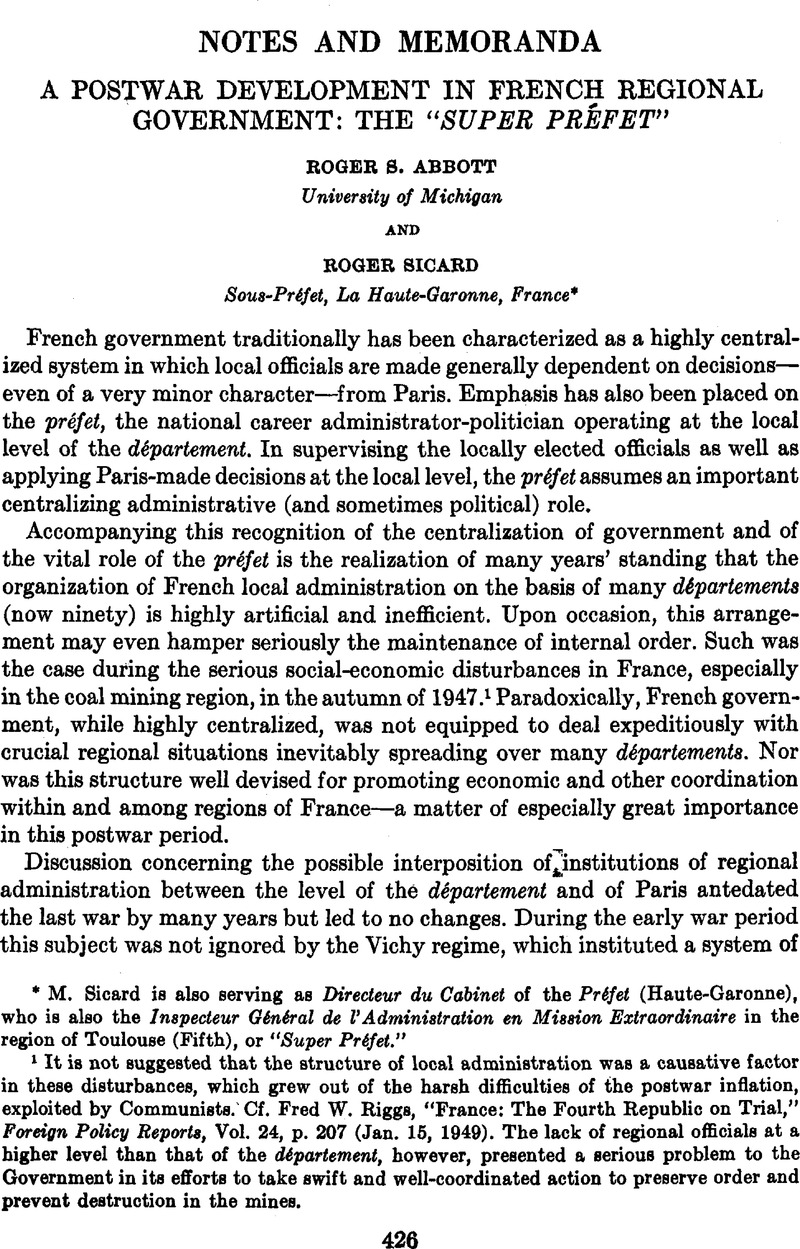No CrossRef data available.
Published online by Cambridge University Press: 02 September 2013

1 It is not suggested that the structure of local administration was a causative factor in these disturbances, which grew out of the harsh difficulties of the postwar inflation, exploited by Communists. Cf. Riggs, Fred W., “France: The Fourth Republic on Trial,” Foreign Policy Reports, Vol. 24, p. 207 (Jan. 15, 1949)Google Scholar. The lack of regional officials at a higher level than that of the département, however, presented a serious problem to the Government in its efforts to take swift and well-coordinated action to preserve order and prevent destruction in the mines.
2 Space limitations do not permit an analysis of this development. Suffice it to mention that a Décret of April 19, 1941, created in the southern unoccupied zone six prefectoral regions: Lyon, Marseille, Montpellier, Clermont-Ferrand, Limoges, and Toulouse. Notwithstanding a reference to the need for institutions of regional administration and coordination, the regional préfets were merely endowed with special police and economic powers (rule-making power relating to production, rationing, and price control).
3 Ordonnance of January 10, 1944. Their powers related generally to maintenance of public order, economic affairs, legislative elimination of Vichy laws and regulations, and certain emergency matters. Their number was not fixed.
4 This was especially true in the region of Toulouse, which had practically no effective communications with Paris for a few months. The statement regarding unprecedented decentralization is based partly on observations of one of the authors (Abbott) during his service as economic analyst in southern France for the Auxiliary Foreign Service. The increased scope of local initiative in decision-making, however, proved to be very ephemeral.
5 Enacted March 21, 1948.
6 Although the term super préfet” appears in the title of this article and has been employed rather widely by the French press, it was decided to use the more exact term Intpecteur Général during the course of this analysis. An evaluation of the validity of the former term may be inferred from this article.
7 Indirectly, this was given emphasis by Moch in that he sought to assure the préfets (members of a special career service directed by the Minister of the Interior) that they would continue to exercise the existing functions. The only change would be that the Inspecteurs Généraux would receive from the Minister of the Interior certain of his own powers. Rather than a decrease in the functions of the préfets, this would amount to a certain decentralization from Paris. This assurance reflected, in part, the Minister's desire to maintain the esprit de corps of the préfets and, in part, the influence and political pressure of these officials.
8 The former category includes the regions of Toulouse, Rennes, and Dijon. For civil administration the headquarters cities are poorly located in the regions of Bordeaux, Marseille, Metz, and Lille. The region of Lyon is so constituted that communication between distant points is quite difficult. The number of départements within a region varies from eight to thirteen.
9 Décret of March 4, 1948. In addition to the Inspecteurs Généraux, there are several assistant grades of inspecteurs and adjoints à l'inspection.
10 M. Moch had reference to the second wave of strikes during October and November, 1948, succeeding the first in October, 1947, which had inspired the creation of the new institution. The 1948 disorders were more easily suppressed. He suggested to the préfets in his audience that they—like himself—had felt more secure this later time due to the sureness of decision and rapidity of execution resulting from the effective decentralization of authority to these new civil officials in the regions concerned.
11 In July, 1949, the ratio was altered to five resident in the regions and three in Paris. One of those resident in Paris, M. Jouany, interestingly, was appointed to the Conseil d'Etat, where his administrative knowledge is put to another use. His successor, M. Haas-Picard, is also Préfet of la Côte-d'Or.
12 Informally, the Inspecteur Général may make suggestions (e.g., regarding the budget of the département or commune), which he can ask the appropriate préfet to pass on to the assembly.
13 The relationships between the préfet and the département are still governed by the law of August 10, 1871, and those between the former and the commune by law of April 5, 1884.
14 Article 87: “Les collectivités territoriales s'administrent librement par des Conseils élus au suffrage universel. L'exécution des décisions de ces Conseils est assurée par leur Maire ou leur Président.”
15 This proposal would make the president of the departmental council the chief of departmental administration. The role of the préfet would be concentrated mainly in the area of coordinating the national officials in the area and representing national interests.
16 For example, jurisdiction over roads has been increasingly transferred from the départements to the national government. Prefectoral personnel are now under national control. Departmental property has been turned over partially to national direction, etc.
Comments
No Comments have been published for this article.